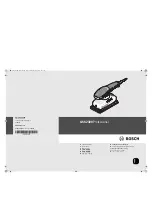
OPERATING INSTRUCTIONS
NOTE
The tool may become hot at low speeds. To aid in
cooling the motor, periodically set the speed to a
higher value and run the tool with no load.
Dust suction
• Efficiency and durability of sandpaper are much improved
by dust suction through the apertures in the disc and
sandpaper.
• Dust collector must be emptied regularly.
Vacuum adaptor
• The adaptor ensures coupling to a vacuum cleaner in
case of increased dust generation.
• Dismount the collector and fasten the tool to a vacuum
cleaner.
Sanding surfaces
• Place the machine flat on the work piece, ensuring
the entire plate makes even contact.
• Turn on the sander.
• Apply uniform sanding pressure.
• Adjust the tool speed & pressure to suit the work
as required.
Rough sanding
• Attach a sand paper with coarse grain.
• Apply only light sanding pressure to achieve increased
material removal.
Fine sanding
• Attach a sand paper with fine grain.
• With moderate pressure, move the machine in a circular
pattern or alternately in lengthwise and crosswise
directions over the work piece.
NOTE
Less sanding pressure increases the sanding
capacity and protects the machine and the sanding
paper.
NOTE
The removal capacity and the sanding pattern are
determined mainly by the selection of the sand
paper (grade), the speed of the sanding pad and
the application pressure.
NOTE
For faster material removal, do not increase
pressure on the tool; instead use a coarser sanding
sheet.
NOTE
Do not tilt the machine during operation. This will
apply uneven pressure, and may cause damage to
the work piece (e.g. when sanding veneer).
NOTE
To avoid marring the finished surface, switch off
the machine, and only lift it from the work piece
when it has come to a stop.
Orbital sanding
• Guide your sander parallel to the working surface
and move it in circles or in a cross pattern.
• The speed of the orbital motion of the sanding pad
is reduced as applied pressure increases.
Selecting the right grade of sandpaper
• Use coarse grits toss and down rough finishes, medium
grit to smooth the work and fine grit to finish off.
• The higher the grade number, the finer the grit.
• For rough work start with a low grade or grit.
(e.g. 60 grit) and change to a higher, finer grade
(e.g. 120 grit) for finishing.
• If you use a fine grade for rough surfaces it will clog
and need changing more frequently.
NOTE
The correct grade for your application will depend
on tool speed, material and pressure applied.
Always test on a scrap piece of material if possible.
MAINTENANCE
WARNING
Switch off the tool and disconnect
the power (remove battery/unplug) before cleaning
and maintenance. This helps avoid the risk of electric
shocks and accidental starting.
• Wipe the tool with a dry or damp cloth. Do not use a wet
cloth.
Do not use detergent that contains solvent or
corrosive, abrasive additives.
This risks damaging
the surfaces of the tool.
• Clear the tool vents and the accessory mount of dust
and dirt after each use.
Do not clean ventilation holes
by inserting sharp objects in them, such as
screwdrivers and other similar objects.
• Stubborn contamination in areas hard to access can be
removed with compressed air (max 3. bar).
• Regularly check all fasteners, screws and bolts to make
sure that they are tight. Tighten any loose screws
immediately or serious injury could occur.
• If the power cord becomes damaged and replacement
is necessary, this must be carried out by an authorized
warranty agent.
WARNING
Never open the tool. The tool has no
internal parts that the user can service or repair.
Never try to repair the tool yourself. Take to an
authorized service center.
NOTE
The correct speed for your application will depend
on grade, material and pressure applied. Always
Always test new settings on a scrap piece of
material if possible.


































